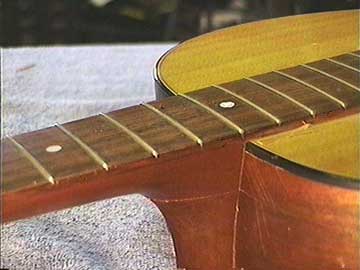FRETS.COM
Quickie
Much more effective than a syringe
"Hydraulic" Glue Injection
© Frank Ford, 10/6/98; Photos by FF, 10/6/98
Here's the problem. The logical and easiest way to fix this cracked heel is glue
and clamp it:

But the crack is very tight, so getting the glue all the way in seems impossible.
I'll remove the inlay by drilling a 3/32" hole right through it:

And crunching out the dot in little pieces:

That's the 100% safe way to remove a dot inlay without damaging the fingerboard.
I'll replace
the dot later.
Now, I'll mark a 3/16" drill bit so I can drill down through the fingerboard
to about 1/4" below the level of the crack:

Here goes:

I'm drilling straight at first to get my bit started, then I'll lean the drill toward
the soundhole a little to drill right to the center of the cracked heel.
This is a slightly tricky one, because I drilled right through the Martin square
tube neck reinforcement. If it had been an adjustable truss rod, I'd have taken the
heel cap off, and drilled through the the heel from the back. This technique works
equally well from the front or the back, but it's a lot easier to replace an inlay
dot than it is to reglue and touch up a heel cap.
Here I'm using a disposable pipette to fill the hole with glue:

I'll run in enough glue to fill the hole all the way to the top.
Then, using my 3/16" shank Phillips screwdriver as a piston, I ram into the
hole:

Forcing glue down into the joint, and out the crack:

You couldn't ask for better glue penetration than this!
When you think of the hydraulic pressure, this method has the potential of tremendous
mechanical advantage over a syringe, because the piston has such a small diameter.
The pressure built up is sometimes great enough to force glue right out through the
pores of the wood on end grain like this.
Now, I just clamp up and my neck will be solid again.
For the purpose of demonstration, I'm using Titebond glue. My preference would
be for hot hide glue, but using hot glue requires heating the entire heel to about
100 degrees Fahrenheit, so that the glue won't gel before being clamped.
Check out my article on rope
clamping to get a little extra squeeze on the heel when
it's clamped up.
Back to Index Page







